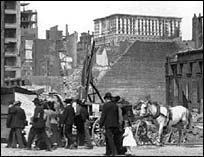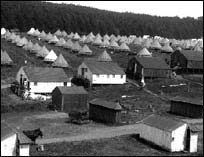|
The 1906 San Francisco earthquake and subsequent four days of
fire were shocking events that brought about revolutionary changes
in earthquake science in the United States, which at the time
lagged behind Europe and Japan.
Prior to 1906, state and city officials frequently dismissed
calls from scientists who wished to conduct earthquake research,
fearing that focusing on the potentially hazardous problem would
be politically and economically damaging to the region.
 After
the Hayward Fault in central California slipped in 1868, there
was wide destruction from San Francisco to San Jose. But a committee
formed by the city to examine what caused the earthquake never
amounted to anything. After
the Hayward Fault in central California slipped in 1868, there
was wide destruction from San Francisco to San Jose. But a committee
formed by the city to examine what caused the earthquake never
amounted to anything.
"There is the allegation that it was suppressed by the business
community in order to save the reputation of San Francisco as
being an earthquake-prone place," said Stephen Tobriner,
a professor of architectural history at the University of California
at Berkeley.
That all changed when early in the morning on April 18, 1906,
a 7.9 magnitude earthquake occurred.
The quake rocked the city for nearly a minute, and was felt from
southern Oregon to south of Los Angeles and inland to parts of
Nevada. Fires broke out and San Francisco was largely destroyed,
with over 28,000 buildings in ruin. Over 3,000 people were killed,
and about 225,000 people from a population of about 400,000 were
left homeless.
With officials unprepared for such an event, rampant looting
took place, and police issued a shoot-to-kill order. All accounts
evidence a chaotic event much like the flooding of New Orleans
following Hurricane Katrina in August and September 2005.
The scope of the disaster was quickly felt in political circles.
Three days after the earthquake, Gov. George Pardee ordered an
investigation into earthquakes in California to be run by a commission
of geology experts. The commission was led by Andrew Lawson, chairman
of the geology department at the University of California at Berkeley,
and included professors from Stanford University, the Chabot Observatory
in Oakland and Johns Hopkins University.
The resulting Lawson report, published in 1908, was the first
integrated, government-commissioned earthquake investigation in
the United States and perhaps the most significant and important
study of earthquakes in the 20th century.
 "To
this day, the report remains a document of the highest regard
among seismologists, geologists and engineers -- a benchmark for
future, integrated investigations into the effects of earthquakes
in the U.S.," wrote Paul Reasonberg of the U.S. Geological
Survey. "To
this day, the report remains a document of the highest regard
among seismologists, geologists and engineers -- a benchmark for
future, integrated investigations into the effects of earthquakes
in the U.S.," wrote Paul Reasonberg of the U.S. Geological
Survey.
Scientists who studied earthquakes in the 19th century knew that
fault lines -- the lines between plates of the Earth's crust,
or tectonic plates -- existed. But they failed to associate the
fault lines with earthquakes.
A member of the Lawson Commission, Johns Hopkins professor H.F.
Reid, made the crucial finding. Called the "theory of elastic
rebound," the theory is still considered the underlying principle
of earthquake science because it explains what causes earthquakes.
The elastic rebound theory says that plate motion in the Earth's
crust accumulates energy just below the surface and elastically
distorts the crust. When the crust can distort no more, it slips
rapidly along a fault line and then returns to its undistorted
state. This slip releases years of strain and generates seismic
waves that produce shaking.
Making the connection between earthquakes and fault movements
provided a blueprint for earthquake scientists for years to come.
"The elastic rebound hypothesis was one of the major contributions
from the study of the 1906 earthquake," said Mary Lou Zoback,
a senior research scientist at the U.S. Geological Survey. "It
is still accepted today as a basis for seismic hazard assessment,
despite that the basis for large-scale horizontal displacements
wasn't established until the plate tectonic revolution six decades
later."
The report also demonstrated the importance of observation. Before
1906, American scientists were aware of fault lines -- later discovered
to be borders between tectonic plates. After 1906, the commission
quickly went to work mapping the San Andreas Fault, which they
suspected played a role in the disaster. Experts believe that
this may have been the first time an entire fault line was mapped.
Researchers followed the fault south to San Bernadino, along
hills of poison oak and small ponds, until the entire fault was
mapped. As they tracked the fault, they noticed evidence of past
movement, the result of 19th century earthquakes in Southern California.
 "What
was learned by scientists after 1906 really provides an underlying
basis for modern earthquake study," Zoback said. "What
was learned by scientists after 1906 really provides an underlying
basis for modern earthquake study," Zoback said.
In the years following the earthquake, an academic movement grew
out of the Lawson Commission's work.
Based in the bay area, the Seismological Society of America was
founded in 1906 and by 1907 had, according to board minutes, "about
145 members."
There were also significant efforts to change the way the public
thought about earthquakes. A written history of the organization
posted on its Web site, noted that in a 1908 meeting "again
the comments came up that newspapers try to suppress information
on damage done by earthquakes as being 'unfavorable in a commercial
way.'"
The historical account also mentions that "the point was
made that the Society 'should strive in a dispassionate way to
inform the public that the recurrence of earthquakes is inevitable
but that with the observation of proper precautions (concerning
which information should also be disseminated) except in very
rare instances they need not greatly be feared.'"
By 1911, the Society had its own publication, the Bulletin, which
was published by Stanford University Press. Lawson was one of
the officers in change of publication.
The first course in seismology -- though its title was disguised
-- appeared at the University of California at Berkeley in 1912.
"So many studies of earthquakes which were detrimental to
the state's economic health had to be disguised or the people
who undertook them were persuaded from doing it. And it took some
time after 1906 for economic forces to be somewhat overthrown,"
said Phillip Fradkin, a journalist who has long covered earthquakes
in California.
The gradual acceptance of uncontrollable forces of nature moved
the architecture community in California to create some of the
safest building standards in the world and enabled the scientific
and health communities to explore innovative new forms of prediction
and preparedness.
-- By James Yolles, Online
NewsHour
|





